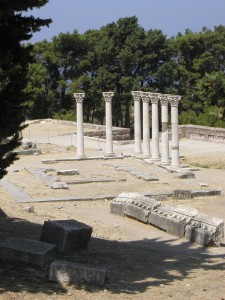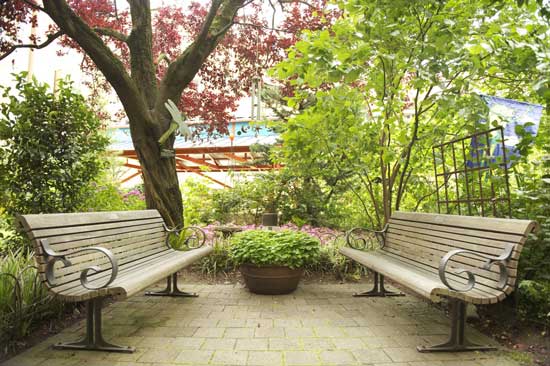Haec fuere numinum templa, priscoque ritu simplicia rura etiam nunc deo praecellentem arborem dicant; nec magis auro fulgentia atque ebore simulacra quam lucos et in iis silentia ipsa adoramus…- Pliny the Elder
A translation of this latin quote reveals the early Greek belief and use of natural areas for healing. “The trees formed the first temples of the gods, and even at the present day, the country people, preserving in all their simplicity their ancient rites, consecrate the finest among their trees to some divinity; indeed, we feel ourselves inspired to adoration, not less by the sacred groves and their very stillness, than by the statues of the gods, resplendent as they are with gold and ivory….”

Temples for the Greek god of healing, Asclepius, were built in pastoral settings with mineral springs, bathing pools, gymnasiums, and healing gardens. Here people would come to worship, lodge, recreate, and heal. The use of a garden as a healing place can be traced back to other early Asian, Greek and Roman cultures. Two thousand years later, a modern application and interpretation of the links between human health and the life world around us can be found in the field of Horticultural Therapy.
Horticultural therapists have a foundation of knowledge in plant science, human science, and horticultural therapy principles and experience. Horticultural therapists may guide participants through a therapeutic garden, bring plant materials into a facility, or bring their services to clients in a private residence. Horticultural therapy (HT) techniques are employed to assist participants to learn new skills or regain those that are lost. HT helps improve memory, cognitive abilities, task initiation, language skills, and socialization. In physical rehabilitation, HT can help strengthen muscles and improve coordination, balance, and endurance. In vocational HT settings, people learn to work independently, problem solve, and follow directions.

This past week, the American Horticultural Therapy Association annual conference took place in Portland, Oregon. Several hundred practitioners and researchers gathered to share their expert knowledge and joy of horticulture as therapy. We present a small sample of research and outcomes presented during the conference:
Designing, Programming and Assessment Tools in Behavioral Health Therapy Garden
A landscape designer, a nurse and a horticultural therapist work together to design and provide the best care for adults and adolescents with behavioral health needs. An interior garden at a Portland hospital was re-designed according to universal access and safety guidelines. In their everyday practice, the nurse and horticultural therapist work together to bring patients into the space and provide healing opportunities for them. For these patients, a garden is a safe place to relax, walk, engage the senses and play. Patients are also connected with community college opportunities, garden volunteering, and learning to grow their own food. We welcome you to learn more about Legacy Health horticultural therapy programming.
What If Your Garden Spanned Four Counties? Using Nature and Civic Innovation to Create Health at a Metropolitan Scale
The Intertwine Alliance is a coalition of public, private and nonprofit organizations working in tandem to integrate nature more deeply at the city scale. The Intertwine Alliance leaders, Mike Wetter and Philip Wu, asked conference attendees to imagine their whole city is a healing garden. A city is potentially millions of people with health needs, watersheds and highways are large-scale landscaped green spaces, and all citizens can provide health and human services to their loved ones or in their career. City organizations working together have the potential to create healthy change at a large scale. Find out more by visiting theintertwine.org
